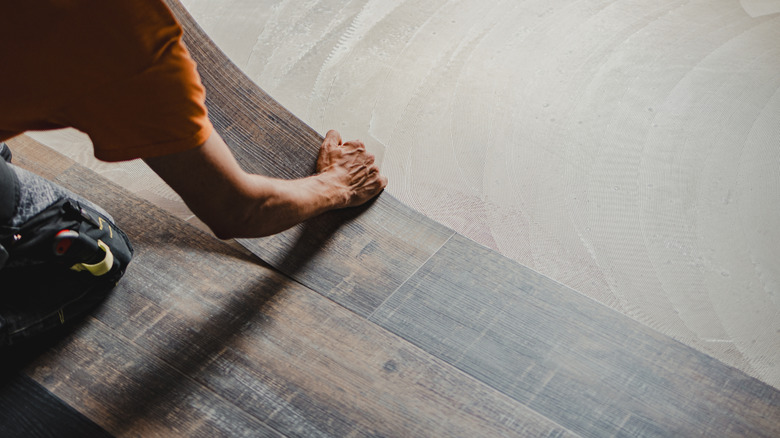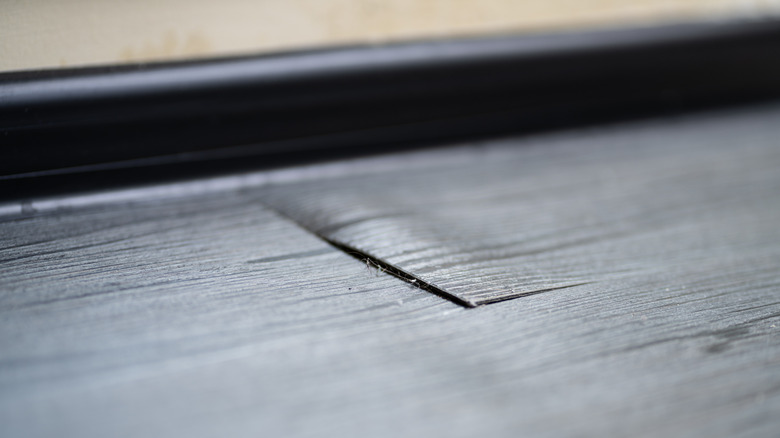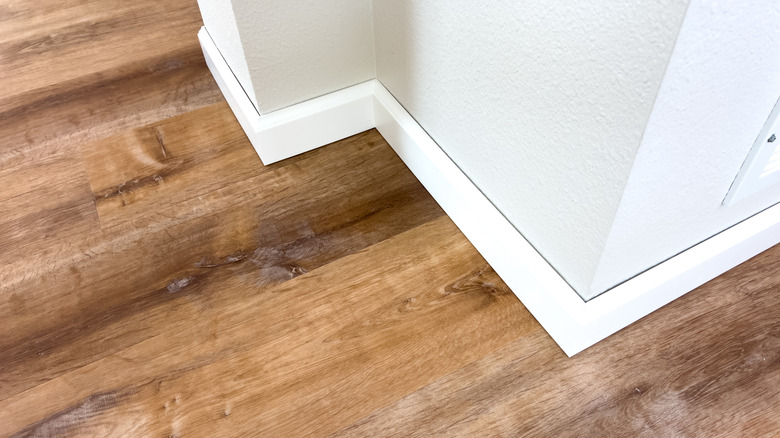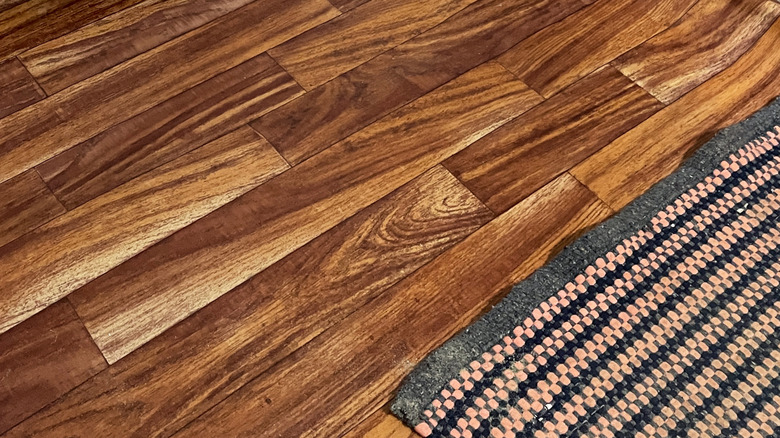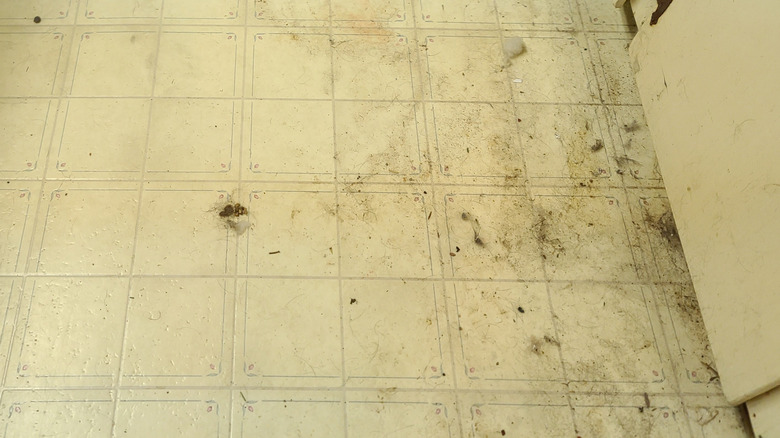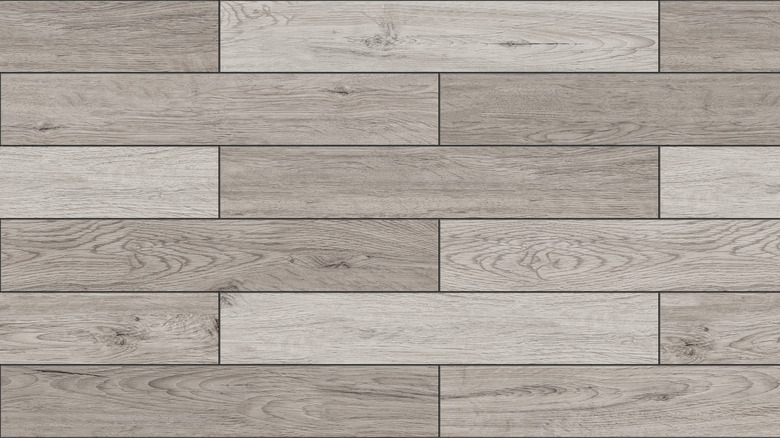12 Telltale Signs Your Vinyl Flooring Wasn't Installed Correctly
Vinyl flooring has plenty of perks. It's a strong material that is also more affordable than wood or ceramic tile flooring. Wood flooring costs between $2 and $13 per square foot, while ceramic flooring costs between $3 and $15 per square foot. Your standard vinyl plank only costs between $2 and $7 per square foot. You'll never get a splinter from a vinyl floor, and the floor also won't crack like tile. The material is even easy to clean and can last up to 20 years. It's also easy to install yourself, which can save you thousands of dollars on labor. Contractors charge anywhere between $5.25 and $13 per square foot for hardwood installation alone. But when vinyl flooring isn't installed correctly, it can warp or even allow water to damage the subfloor.
Vinyl, also known as polyvinyl chloride or PVC, for short, is a synthetic resin that has become one of the most popular plastics over the past century because of its low production cost and versatility. It was synthesized in Germany in the 1870s, but it did not become commercially viable until the 1920s when American chemists at the B.F. Goodrich Company learned how to plasticize it, making the material flexible. This quality, as well as its waterproof nature, makes it ideal for flooring. However, it does respond to humidity and temperature, expanding and contracting throughout the seasons. This can cause the material to buckle, bubble, and curl over the years if it isn't installed properly. Watch for these signs that your contractor messed up and possibly voided the warranty with bad installation.
A squishy or bouncy feeling underfoot indicates incorrect underlayment
You may notice that your floor feels bouncy as you walk on it, as if it is resting on a squishy layer. This is usually the result of contractors putting the wrong underlayment beneath the vinyl. Underlayment is a soft, mat-like material that covers the subfloor — a plywood layer that sits on top of the house's joists. Underlayment protects your flooring against moisture from underneath the house and provides a more level surface by smoothing imperfections in the subfloor.
Remember that vinyl will always respond to pressure by bending. That's why the incorrect use of underlayment adds stress to the planks or tiles. Some vinyl flooring comes with attached padding and won't require underlayment. Adding padding in this case could cause the floor to become too flexible and doing so can void your warranty. As you walk across the floor, it will bounce along with the spongy underlayment, and this movement can add pressure to the click-and-lock joints that hold the planks together. Always check the manufacturer's guidelines to determine the correct type of underlayment, which varies by thicknesses and material and can be made with foam, felt, or cork.
Buckling can be the result of floaters being glued down
The distinction between glue-down planks and floaters is one of the most important things you need to know about vinyl flooring. Floaters are specially designed to expand and contract with temperature changes and humidity. This even allows the floor to adjust over time as the house settles. Instead of being glued down, floating pieces simply lock together, and the pressure they exert on one another holds the floor in place. The biggest mistake people make when installing floaters is gluing or nailing them down.
Buckling can also when planks or tiles are pressed together so tightly that they shoot up. Floaters usually don't buckle, because they are free to move in response to pressure. Securing a floater to the subfloor restricts its movement. If the floor shifts, planks act as tectonic plates and crash together, causing a mini mountain range in the middle of your living room. The adhesive will eventually respond to the pressure of the swelling or shrinking planks and fail. You may even hear this cracking as you walk through that room. Aside from the aesthetic consequences, using adhesive on floating planks will likely void the product's warranty.
Creaking sounds suggest that the planks weren't glued down properly
Some vinyl tiles and planks are meant to be glued directly to the subfloor. This flooring should stay secure for a long time, and is suitable for high-traffic spaces. These tiles won't shift over time, and they also do not click together like floating vinyl flooring. They are often used in commercial settings like large kitchens or warehouses where heavy material is moved in and out. If you have glue-down flooring, you also don't have to worry as much about moisture seeping into the subfloor, because the adhesive forms a barrier. That's why this is a good flooring type for public restrooms. The installation is far more complicated and expensive than click-and-lock flooring, which is why most homeowners who want this type of flooring hire professionals to put it down. Improper installation can lead to creaking noises that are hard to fix.
This floor should be quiet underfoot because its pieces are glued firmly in place and don't rely on interlocking joints. But the glue on the edges of these tiles can lose its adhesive properties, allowing the edges to curl. This will not only make your floor uneven, but it will also cause the tiles to rub together as you walk on them. The problem will only get worse over time, so you should try to address it immediately. Removing these tiles can be a challenge and can even damage the subfloor, so it's best to have a professional handle repairs.
Buckling planks indicate that proper expansion gaps weren't used
You may pull up a buckling floater and realize that there isn't any adhesive on the bottom. This is common, as there are several reasons why a vinyl plank might buckle. When you pull up those floaters, you may also find that the subfloor is dry. Without moisture, how can a plank buckle? The answer is humidity. This is more of a problem in parts of the country with particularly high humidity, like the South. One perk of vinyl flooring is that it doesn't absorb as much moisture as wood, so it experiences less drastic fluctuations in size. The best way to prevent distortion from high humidity is to employ the right expansion gap, which allows the planks to expand without pressing too hard against each other.
An expansion gap is a space left around the perimeter of the room that enables your flooring to stretch and contract throughout the year. The manufacturer provides detailed guidelines on how to install flooring with the proper expansion gap. This gap is usually between 4 millimeters and 8 millimeters, and it prevents your floaters from buckling with natural expansion. Molding around your room's perimeter will cover the expansion gap. You can check to see if you have an expansion gap by removing a piece of molding during a season of low humidity and looking for the space.
Bubbling or lifting planks are a sign that adhesive was improperly installed
Sometimes vinyl flooring will bubble, lifting off the subfloor. You may find several different bubbles across the floor or even one large bubble in the center of the room. These bubbles will feel like squishy spots that will be noisy to walk across. They form for the same reasons that pieces tend to buckle. When a vinyl floor doesn't have an expansion gap or hasn't been allowed to adjust to a room's climate before installation, the humidity of the summer will make the material to swell and press against the edges of the room. This can cause the planks to lift off the subfloor. The bubbling may go away as the seasons change and the air dries, but it will return the next summer. Over the years, the floor will develop damage as the joints holding each plank together wear out.
But bubbling doesn't just happen to click-and-lock joints. Glue-down tiles can also bubble when trapped moisture degrades the adhesive, causing the tiles to become unstuck for the subfloor. This is more common with older floors when the adhesive has had time to weaken. The right adhesive might not have even been used in the first place. You can fix this issue by injecting adhesive under the bubbles or, in more severe cases, removing sections of flooring.
Premature wear and tear can be caused by an uneven subfloor
Bumps and impressions in the subfloor will affect your vinyl flooring over time. There might be a row of nails that weren't pounded as deeply into the wood as they should have been. Or perhaps your contractor forgot to sweep up a small pile of wood shavings. The subfloor may have even warped from moisture. Thanks to those chemists at the B.F. Goodrich Company, your vinyl flooring is quite flexible, and it will adjust to the contours of any subfloor — but that's not always a good thing.
At first, this problem will likely manifest as a mild annoyance. You will feel bumps as you walk across the floor, but they won't be pronounced and you can easily ignore them. The floor may even hold firm with one step and move slightly with another. But as the years pass, these contours will be harder to ignore, because they'll undergo premature wear and tear, even changing in color as their faux-wood design rubs off. Of all the things you should never do to a vinyl floor, make sure not to drag heavy objects across one that is bumpy because it will cause damage. The only solution to this problem is to pull up the vinyl, even out the subfloor, and put down a proper underlayment.
Excess creaking or crunching sounds are a sign that the subfloor was not properly prepared
Creaking sounds usually indicate that your vinyl flooring is bending as you walk across it. This often happens when vinyl planks are laid across high and low points in the subfloor instead of an even surface. While the creaking is annoying, it's also the sign of a larger issue unfolding. An uneven subfloor will not hold together properly over time, and creaking is an indication that too much pressure is being applied to the click-and-lock joints of your flooring. You may even notice that the creaking depends on the season. As previously mentioned, high humidity causes the planks to swell up, which can cause a little more rubbing than usual.
Creaking is not the only sound that might come from your vinyl flooring. For instance, if you hear the crunching of tiny stones as you walk through a room, it might be a sign that there isn't an underlayment.In cases like this, the vinyl floor is grinding tiny stones into the concrete subfloor. This can also lead to wear and tear on your vinyl. It's a common issue in basements, and can only be corrected by removing the vinyl flooring and adding a proper underlayment.
It's also possible that the creaking did not originate in the vinyl flooring itself. The joists and the subfloor could also be rubbing together, and you should rule out that possibility before tearing up your vinyl flooring.
Dark spots are a sign that the underlayment was wet upon installation
Discoloration on your vinyl floors — especially spots that are impossible to wash off — could signal a problem with the flooring itself. Dark spots can appear for several reasons, ranging from moisture between the vinyl and the subfloor to chemical discoloration. But in many cases, dark spots are the result of poor maintenance.
Start by checking for leaks in your bathroom or kitchen that might be allowing water to reach the subfloor. Mold will grow on the underside of your vinyl floor and eventually spread to the visible side. Leaks are costly problems and addressing them quickly is key. If you do find a leak, at least part of the flooring will have to be removed to dry out the subfloor.
If you used an adhesive to secure your flooring, a chemical reaction could be causing the discoloration. This can also be related to excessive moisture beneath the vinyl as well as temperature changes. Chemical reactions can often occur while using rubber-backed rugs, leading to dark or yellow spots. You can prevent this type of chemical reaction from happening on your vinyl floor by using vinyl-safe pads and breathable rugs.
A strong smell could indicate a wet subfloor
The subfloor should be completely dry before you put down your underlayment or vinyl flooring. Otherwise, the wood will grow moldy and produce a foul odor. Vinyl flooring is relatively water resistant, but it's not waterproof. That's why any moisture will either stay trapped beneath your vinyl planks or be absorbed into them. This can lead to warping and additional wear and tear on the raised parts of your floor.
Most homeowners know that their wood subfloors can hold moisture, but they might be surprised to learn that concrete subfloors can also hold moisture. Concrete subfloors are porous, so they will release that moisture over time into your vinyl flooring, causing a lot of damage. To protect your vinyl floors, your underlayment should have a built-in moisture barrier, especially if the subfloor is made of concrete.
You can't fix a moldy subfloor without tearing up the vinyl and removing the underlayment, which is a costly endeavor. You may also have to replace parts of a wooden subfloor if it's rotting. If you notice a musty smell, act quickly. Mold can spread throughout your house and cause serious health issues, including lung inflammation, shortness of breath, and fungal infections.
Similar patterns were placed next to each other
Sometimes you'll look at a vinyl floor and feel that something is off. The planks are firm and flat, but something is off, and you're not quite sure what it is. The problem may be that the contractor neglected to diversify the plank patterns when they laid the floor. This issue has nothing to do with the structural integrity of your floor, but it is still significant.
Vinyl flooring is usually patterned to resemble wood, but each box of planks repeat several of the same patterns. If you pull pieces straight out of the box without paying much attention, you might mistakenly place identical pieces alongside each other. Vinyl flooring typically mimics wood fairly well, but when these identical planks are placed alongside one another it's a giveaway.
Pieces should not only be diverse in design but also in length, so contractors need to plan accordingly. Mistakes occur when a contractor starts laying long pieces at one end of the room, and by the time they reach the opposite end, only short pieces are needed to fill the space. If long pieces of flooring are used at one end of the room and only short pieces are left for the other end, the floor won't look right.
Your vinyl plank seams form an H pattern
Not all aesthetic crimes are without structural consequence. That's why it's important to properly stagger vinyl planks. Failure to do so leads to H-joint patterns where planks line up exactly in every other row. Skilled contractors avoid H-joint patterns by measuring their boards and placing them in an intentional way that appears arbitrary. That's because they know that H-joint patterns are not just visually offensive but also place larger amounts of stress on the locking mechanisms. These planks will end at the same point, compromising the strength of the floor as the seams experience repeated pressure.
Another staggering mistake occurs when neighboring boards end in the same place. This unsightly mistake will make you want to tear up the faux floor boards every time you see them, and the only way to correct this problem is to do just that, placing pieces in a pattern that looks at once natural and random. Once the floor is fixed, it will evenly distribute weight, rather than concentrating it in specific pressure points along the aligned seams. You can also get a sheet of vinyl flooring instead of planks and never have to worry about seams.
Improper spacing between vinyl flooring and fixtures
Vinyl does not just swell against the edges of your room. It also has a tendency to expand and curl around objects that you might find throughout your house. There needs to be proper spacing between vinyl edges and objects such as water pipes and radiators. Anything that produces heat is likely to cause the vinyl to expand more. If you find vinyl curling against these types of objects, you know that the floor was not installed correctly. If you have any support beams in your home, you also need to provide the correct expansion gaps.
Proper installation in these cases usually involves cutting the vinyl to create an expansion gap to match the gaps along the edges of the walls. A good contractor will usually design a molding to run along these fixtures. Improper expansion gaps around fixtures will also cause bubbling.
